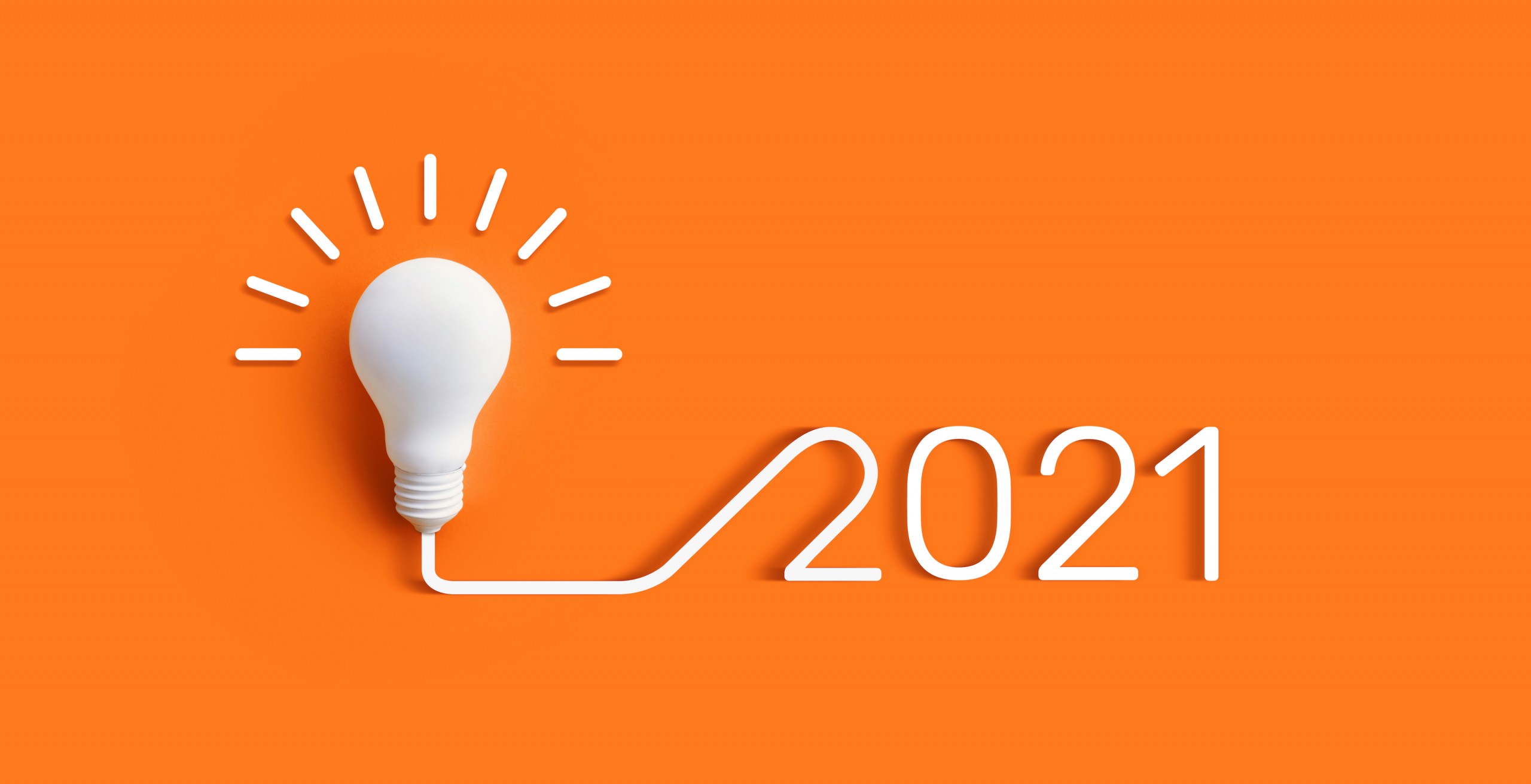After the challenges of 2020, we’re finding excitement as we turn toward the beginning of a new year that offers the chance to look back but, more importantly, look forward to new opportunities. We wanted to know what technologists in our industry are excited about and expect (or hope) to see in 2021. So we asked the NAB Technology staff, some of our NAB committee leaders and a few other luminaries in the industry if they had anything to share. They did.
Even though, as risk management expert David Hulett tells us, “there are no facts about the future,” this compilation of predictions is our way to wrap up 2020 by looking forward to 2021.
One-On-One Local News Conversations with Voice Platforms

In 2021, consumers will have one-on-one conversations with their preferred local news providers over voice platforms. Chatbots and messaging apps with these kinds of personalized “conversations” are already prevalent in other areas (e.g., customer service apps), including news. As these interactions extend to voice platforms, we’ll see local news being delivered not just as a request for a headline but as a conversation about a headline. These conversations may be rudimentary, but it’s a significant step toward a more personalized, voice experience with news and information.
John Clark, executive director of PILOT, National Association of Broadcasters
Local News Emerges Nationally as a Killer App for Next Gen TV
 It began early in 2021 at a single station in a “flyover state”—an engineering intern from a small college at a small TV station in a small town wrote an app for the station’s newly launched Next Gen TV service that, using an intelligent search algorithm, selected relevant local news content published on the station’s website and made it available via a simple user interface to viewers watching linear programming on new NEXTGEN TV receivers. It was an instant hit—people watching TV at an any hour suddenly had on-demand on-screen access to the latest newscasts and in-depth news stories of interest to them without leaving their regular TV shows. Since the content was already in place on the website, it was quite easy to implement for the station and instantly appreciated by their viewers. The idea spread quickly locally and then social media and stories on a several popular syndicated radio and TV programs brought national attention and proliferation of the idea on stations across the country. With Next Gen TV expected to be live in almost 100 markets by the end of 2021, and broadcasters being hyper-competitive businesses in the area of news reporting, the local news app is estimated to be available to the vast majority of Americans by the end of 2021 and is acting as a clear accelerant to consumer adoption of NEXTGEN TV as the must-have TV feature.
It began early in 2021 at a single station in a “flyover state”—an engineering intern from a small college at a small TV station in a small town wrote an app for the station’s newly launched Next Gen TV service that, using an intelligent search algorithm, selected relevant local news content published on the station’s website and made it available via a simple user interface to viewers watching linear programming on new NEXTGEN TV receivers. It was an instant hit—people watching TV at an any hour suddenly had on-demand on-screen access to the latest newscasts and in-depth news stories of interest to them without leaving their regular TV shows. Since the content was already in place on the website, it was quite easy to implement for the station and instantly appreciated by their viewers. The idea spread quickly locally and then social media and stories on a several popular syndicated radio and TV programs brought national attention and proliferation of the idea on stations across the country. With Next Gen TV expected to be live in almost 100 markets by the end of 2021, and broadcasters being hyper-competitive businesses in the area of news reporting, the local news app is estimated to be available to the vast majority of Americans by the end of 2021 and is acting as a clear accelerant to consumer adoption of NEXTGEN TV as the must-have TV feature.
Lynn Claudy, senior vice president of Technology, National Association of Broadcasters
2021: Radio Reaffirms its Dominance in the Dashboard
 While 2020 was an extremely trying year for us all, broadcast radio showcased the vital role it plays in the community. Never before (at least in my lifetime) has local information and community been more important than during this pandemic. The critical role that radio has played to inform, calm and entertain has really come through loud and clear. 2020 also saw the achievement of two great milestones in radio technology with the approval of All Digital AM HD Radio and the launch of DTS Connected Radio. While both of these technologies have been in development for some time, thanks to broad support of U.S. broadcasters and regulators, both services are now available for consumers to enjoy in 2021. With 75 million HD Radio equipped cars on the road, look out for launch of some very exciting all digital AM formats and be sure to get a ride in a new Mercedes to get a glimpse of what will become the connected car radio experience of the future.
While 2020 was an extremely trying year for us all, broadcast radio showcased the vital role it plays in the community. Never before (at least in my lifetime) has local information and community been more important than during this pandemic. The critical role that radio has played to inform, calm and entertain has really come through loud and clear. 2020 also saw the achievement of two great milestones in radio technology with the approval of All Digital AM HD Radio and the launch of DTS Connected Radio. While both of these technologies have been in development for some time, thanks to broad support of U.S. broadcasters and regulators, both services are now available for consumers to enjoy in 2021. With 75 million HD Radio equipped cars on the road, look out for launch of some very exciting all digital AM formats and be sure to get a ride in a new Mercedes to get a glimpse of what will become the connected car radio experience of the future.
Joe D’Angelo, senior vice president of Radio, Xperi Inc
“Just Because You Can, Doesn’t Mean You Should.”
– Unknown origins, but may be traceable to 1 Corinthians 6:12-20.
 The discretion of management in any business is to decide what to do and why. We’ve learned a lot in the COVID-19 pandemic. We’ve found what works well and, perhaps, what doesn’t.
The discretion of management in any business is to decide what to do and why. We’ve learned a lot in the COVID-19 pandemic. We’ve found what works well and, perhaps, what doesn’t.
We’ve found the following:
- Anchor talent can anchor from home
- MMJ, reporters, photographers can work from home
- Salespeople can work effectively from home
- Creative services producers can work from home
- Producers can produce shows from home
- Master control functions can run from home
- Overdrive automation can be programmed and operate from home
- And “home” doesn’t need to be in any specific DMA
In the coming years, will it be more cost-effective to operate a virtual television in the cloud? Especially for companies with leased facilities, this could dramatically cut down the need for expansive facilities, reduce real estate costs substantially and enlarge the available talent pool. With more time, planning and infrastructure, remote work could be more effective. While these changes might be technically feasible, should it be done and what opportunities have been missed?
Broadcasting is a business whose real strengths are creativity, innovation and collaboration. Great ideas generally haven’t come from Zoom or Teams meetings. Great ideas occur socially over the cubicle wall, in the lounge or just hanging out.
Our Technology group’s motto is “Our job is to ensure everyone can do their job.” Many of the things we’ve done during the pandemic will continue. The discretion of the leadership will determine the future success of the business and how that takes shape.
Brady W. Dreasler, corporate director of Engineering, Quincy Media, Inc.
Edge Compute Will Begin to Make Personalized Experiences a Reality
 With an increase in the number of companies developing and launching edge compute products over the course of 2021, we will begin to see how the technology of the edge will define the viewing and listening experiences of tomorrow. With low latency and compute power less than one second away from any user, broadcasters and content owners will gain the power to deliver truly unique experiences to each and every user beyond just the advertising spots.
With an increase in the number of companies developing and launching edge compute products over the course of 2021, we will begin to see how the technology of the edge will define the viewing and listening experiences of tomorrow. With low latency and compute power less than one second away from any user, broadcasters and content owners will gain the power to deliver truly unique experiences to each and every user beyond just the advertising spots.
Jason Friedlander, senior director of Product Marketing, Verizon Media
All Roads Lead to Rome… ATSC 3.0 is the Broadcast Yellow Brick Road!
 The broadcast industry will experience a renaissance as other industries grasp the possibilities ATSC 3.0 has to offer where the new spectrum will provide an additional avenue to reach consumers. As the spectrum penetrates more markets, we will see other sectors get involved and experiment in unique and innovative ways. Competitors may become allies. Relationships in automotive will go beyond ad selling with local dealerships as car manufacturers realize the potential of ATSC 3.0. A terrestrial, over-the-air IP stack will bring in new partners from sectors that exploit internet of things sensors like agriculture, energy and industrial.
The broadcast industry will experience a renaissance as other industries grasp the possibilities ATSC 3.0 has to offer where the new spectrum will provide an additional avenue to reach consumers. As the spectrum penetrates more markets, we will see other sectors get involved and experiment in unique and innovative ways. Competitors may become allies. Relationships in automotive will go beyond ad selling with local dealerships as car manufacturers realize the potential of ATSC 3.0. A terrestrial, over-the-air IP stack will bring in new partners from sectors that exploit internet of things sensors like agriculture, energy and industrial.
Mike Kelley, vice president and chief information security officer, E.W. Scripps Company
U.S. Broadcasters Embrace RadioDNS in 2021
 Hybrid (over-the-air plus internet) radios for autos arrived in the U.S. in 2020 and are expected to become more prevalent in 2021. One of the easiest ways for broadcasters to get their station information (“bearer” information, slogans, station logos, streaming audio URLs, etc.) to display on hybrid radios is by creating a RadioDNS Service Information (SI) file. Broadcasters can do this themselves or work with a number of service providers who can assist free of charge. It’s vital for broadcasters to do this so that automakers can be assured that their investment of time and resources in developing great radio receivers is appreciated and supported. NAB and RadioDNS have made a number of resources available to help broadcasters develop SI files and register with RadioDNS, including a free on-demand tutorial webinar and how-to documents.
Hybrid (over-the-air plus internet) radios for autos arrived in the U.S. in 2020 and are expected to become more prevalent in 2021. One of the easiest ways for broadcasters to get their station information (“bearer” information, slogans, station logos, streaming audio URLs, etc.) to display on hybrid radios is by creating a RadioDNS Service Information (SI) file. Broadcasters can do this themselves or work with a number of service providers who can assist free of charge. It’s vital for broadcasters to do this so that automakers can be assured that their investment of time and resources in developing great radio receivers is appreciated and supported. NAB and RadioDNS have made a number of resources available to help broadcasters develop SI files and register with RadioDNS, including a free on-demand tutorial webinar and how-to documents.
David H. Layer, vice president, Advanced Engineering, National Association of Broadcasters
Predictions for Next Gen TV, Hybrid Radio, NAB Show (and Annoying Echoes)
 Next Gen TV will continue to be deployed across the United States , and by the end of 2021 over 2/3 of all U.S. TV households will be in a market with at least one Next Gen TV station.
Next Gen TV will continue to be deployed across the United States , and by the end of 2021 over 2/3 of all U.S. TV households will be in a market with at least one Next Gen TV station.
2021 will be the year where meaningful deployments of hybrid and connected digital radio will begin to take hold in the automotive sector. As the pandemic subsides, people will use these enhanced platforms to listen to and engage with their favorite stations.
NAB Show will roar back as the world’s largest trade show for media, entertainment and technology in October. With the benefit of a vaccine and time, it will be an early success story leading the way for large scale in-person gatherings.
John Clark may or may not figure out how to eliminate the echo in Microsoft Teams.
Sam Matheny, chief technology officer and executive vice president of Technology, National Association of Broadcasters
ATSC 3.0 and 5G Service Providers Will Realize They Are Playing on The Same Turf
 As ATSC 3.0 and 5G technologies roll out in 2021, service providers will realize that the two technologies enable some common services. 5G service providers will learn about ATSC 3.0 based datacasting use cases, whereas traditional broadcasters will learn about the 5G media production and delivery capabilities. There will be both grounds for competition and opportunities for collaboration. The game will play out for a few years before gravitating towards an equilibrium in terms of optimal services and use cases, but 2021 will be the year the industries will start taking notice of each other.
As ATSC 3.0 and 5G technologies roll out in 2021, service providers will realize that the two technologies enable some common services. 5G service providers will learn about ATSC 3.0 based datacasting use cases, whereas traditional broadcasters will learn about the 5G media production and delivery capabilities. There will be both grounds for competition and opportunities for collaboration. The game will play out for a few years before gravitating towards an equilibrium in terms of optimal services and use cases, but 2021 will be the year the industries will start taking notice of each other.
Tariq Mondal, senior director, Innovation and Emerging Technologies, National Association of Broadcasters
Broadcasters Deliver Interactive Content with Next Gen TV
 Even with all of the challenges of 2020, from COVID-19 to finishing the TV spectrum repack following the 2017 incentive auction, broadcasters launched Next Gen TV in almost 20 markets. With the lessons learned from those early markets, deployments will accelerate in 2021 and reach some of the nation’s biggest cities. Once that happens, broadcasters will be able to really start showcasing some of the cool features the Next Gen TV standard has to offer for broadcast viewers.
Even with all of the challenges of 2020, from COVID-19 to finishing the TV spectrum repack following the 2017 incentive auction, broadcasters launched Next Gen TV in almost 20 markets. With the lessons learned from those early markets, deployments will accelerate in 2021 and reach some of the nation’s biggest cities. Once that happens, broadcasters will be able to really start showcasing some of the cool features the Next Gen TV standard has to offer for broadcast viewers.
Alison Neplokh, vice president, Innovation and Strategy, National Association of Broadcasters
What’s Old Becomes New Again In 2021
 As broadcasters look to build audiences after the disruptions of 2020, I see companies waking up to digital channels that have been available to us all along and getting serious about maximizing their potential. Doubling down on podcasting and social media, producing more digital video (live and recorded) and taking advantage of the built-in discoverability potential of YouTube will all be key as we continue forward in an on-demand and content saturated world. Broadcasters will use these channels to extend their current brands and build new brands for the future, cutting out clutter and focusing on what works.
As broadcasters look to build audiences after the disruptions of 2020, I see companies waking up to digital channels that have been available to us all along and getting serious about maximizing their potential. Doubling down on podcasting and social media, producing more digital video (live and recorded) and taking advantage of the built-in discoverability potential of YouTube will all be key as we continue forward in an on-demand and content saturated world. Broadcasters will use these channels to extend their current brands and build new brands for the future, cutting out clutter and focusing on what works.
Jeremy Sinon, vice president of Digital Strategy, Hubbard Radio

Release of $30 home gateway for Next Gen TV
October 2021 – After a very successful year of rolling out Next Gen TV in markets across the United States, a small upstart company releases a simple, $30 home gateway to spur consumer adoption. Visionary broadcasters see the benefit of this and band together to create a nationwide conversion plan similar to the coupon program used in the analog shutoff. Shortly thereafter, consumer adoption skyrockets, dramatically reducing the transition time and all parties, from the FCC to the broadcasters to the CEA, go home happy!
Peter A. Sockett, director of Engineering and Operations, Capitol Broadcasting Company


